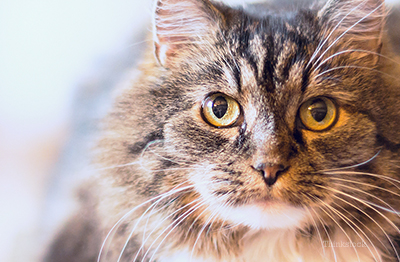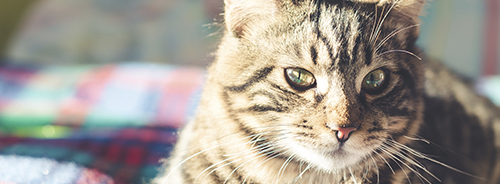
Kidney disease is a common problem in cats, affecting more than 1/3 of older cats1,2. There are a number of causes that may affect different age groups and have different consequences. Ultimately though, chronic kidney disease (occurs over time) or acute kidney injury (occurs suddenly) will always have the same result—a sick kitty. The signs of illness in your cat reflect the failure of the kidneys to do their many jobs well enough. (Click here to learn the basics of chronic kidney disease in cats.)
Below, you will find a brief description of ten common causes of kidney disease. These are the targets of your veterinarian’s testing
1. Infection of kidney tissues (pyelonephritis)
Infection of kidney tissues with bacteria or, rarely, fungal organisms, is one of the kidney diseases that may have a more favorable outcome, so your veterinarian will be on the lookout for it. Our goal with pyelonephritis is to kill the bacteria that cause the damaging inflammation. This should limit progression of any chronic kidney disease or assist with recovery from an acute kidney injury. A bacterial urine culture and susceptibility can verify the infection and identify which antibiotic might work the best.
2. Kidney stones (nephrolithiasis)
Kidney stones can be the product of chronic bacterial infection, genetics or diseases that alter blood or urine characteristics. Nephro (kidney) liths (stones) don’t seem to cause cats much pain, but this can change if they cause blockage within the kidney or its collecting ducts; it can also change if they contribute to infection (See pyelonephritis).
Learn more about kidney stones in cats.
3. Kidney blockage (ureteral obstruction with hydronephrosis)
Kidney stones can fragment and be carried along with urine into the ureter, the long narrow tube that connects each kidney to the urinary bladder. They are probably painful during their transit, and a significant concern is the consequence to the kidney if they become lodged in the ureter, causing partial or complete blockage. New urine cannot exit the kidney easily and it backs up, causing the kidneys to swell. With enough pressure, the kidneys enlarge (hydronephrosis) and become damaged. If both ureters obstruct at the same time, it can prove disastrous.
4. Toxins
Lots of household items can harm the kidneys, not just antifreeze. The petals, leaves and pollen of true lilies, even the water in their vase, can cause severe kidney injury when cats nibble, lick or chew them. This is one floral delivery you should refuse! Common OTC medications, like aspirin, other nonsteroidals (NSAIDs) or prescribed medications, can all cause kidney disease. Cats that are known for being finicky about food, and almost everything else, will still eat pills they find on the counter or floor, so keep all meds in cat- proof containers. And always discuss the use of ANY medications with your vet.
If you have any reason to believe your cat has been poisoned, contact your veterinarian or an emergency veterinarian right away. You may also contact:
- ASPCA Poison Control (888) 426-4435
- Pet Poison Helpline (855) 764-7661
5. Damage to kidney tubules (tubulointerstitial disease)
Inflammation and damage to the kidney tubules and supporting tissues commonly leads to chronic kidney disease. In many cases, there is no identified cause, and thus, no option for specific treatment. This type of kidney disease can only be confirmed by microscopic examination of a kidney biopsy specimen, but biopsies are not usually recommended.
6. Damage to the kidney filters (glomerular disease)
The glomerulus of the kidney (kidney filtration mechanism) can be involved in feline kidney disease. Early on, we expect no signs of illness from this condition, but since glomerular disease may be caused by infections such as FIP/FeLV, or by cancer (amongst other things), time can make the problems worse. Over time, inflammation in the glomerulus of the kidney damages the surrounding kidney tissues, creating chronic kidney disease that makes your cat feel sick.
Learn more about glomerular disease in cats.
7. FIP (feline infectious peritonitis)
The kidneys are a common target for this severe inflammatory disease of domestic and wild cats. Some cats, especially youngsters, develop fever and effusions (fluid buildup) in the chest or abdomen, and decline rapidly. Cats with noneffusive (dry) FIP tend to be older and show more vague signs of illness. Your veterinarian may become concerned about the possibility of FIP when feeling swollen and lumpy, bumpy kidneys (the inflammatory cells may be distorting the outer layers of the kidney).
Learn more about feline infectious peritonitis (FIP).
8. Cancer
Fortunately, kidney cancer is not very common in cats. Unfortunately, treatment options for kidney cancer are rather limited. Solitary tumors, affecting only one kidney, can be removed by surgery with a good outcome, if the cancer is benign or has not spread to other parts of the body (including the opposite kidney). Your cat only needs one good kidney to function normally. If the cancer is more widespread (as usually occurs with lymphosarcoma), surgery will not be an option for a cure. Microscopic analysis of a biopsy or small needle sample is needed for the correct diagnosis of cancer and for an appropriate treatment plan.
Learn the 3 most common cancers in cats.
9. Protein problem (amyloidosis)
Patients with amyloidosis lose function in certain organs, including the kidneys, because protein deposits replace the normal tissue. It is an uncommon consequence of chronic inflammation affecting other parts of the body, or it may be genetically programmed in some breeds, like the Abyssinian, Siamese, or Oriental shorthair. Amyloid deposits cannot be cleared away, and the functional kidney tissue that is lost cannot be replaced, so the prognosis is not good.
Learn more about amyloidosis in cats.
10. Hereditary
Familial kidney disease is well known in the Abyssinian and Persian breeds, and is being found in more fancy breeds. The structural changes it causes are not reversible, but may not cause illness until later in life. Many laboratories offer DNA testing for polycystic kidney disease, so responsible breeders can avoid mating affected cats. Polycystic kidneys develop many small or large grape-like, fluid- filled cysts, beginning early, but the kidneys usually compensate until later age. Cats with amyloidosis (See above.) show signs of kidney disease as young or old cats, so it’s varied in onset.
If you have any questions or concerns, you should always visit or call your veterinarian -- they are your best resource to ensure the health and well-being of your pets.
References:
- Lulich JP, Osborne CA, O’Brien TD, Polzin DJ. Feline renal failure: questions, answers, questions. Compend Contin Educ Pract Vet. 1992;14(2):127–153.
- "Advances in Diagnosing and Staging Chronic Kidney Disease in Dogs and Cats." IDEXX. Web. 21 Oct. 2015.

Cat Kidney Disease Articles
Chronic Kidney Disease: What Does Kidney Failure in Cats Really Mean?Kidney Disease in Cats 101
5 Things Vets Hate About Kidney Disease in Cats … And How That’s About to Change
